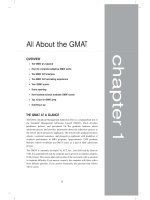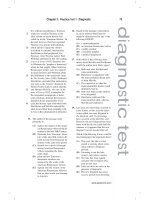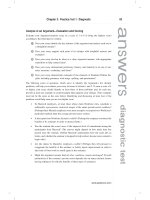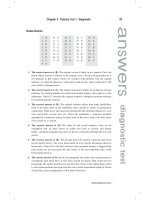Master gmat 2010 part 30 pptx
Bạn đang xem bản rút gọn của tài liệu. Xem và tải ngay bản đầy đủ của tài liệu tại đây (89.04 KB, 10 trang )
Math Review:
Geometry
OVERVIEW
• Lines and angles
• Triangles
• Isosceles and equilateral triangles
• Rectangles, squares, and parallelograms
• Circles
• Advanced circle problems
• Polygons
• Cubes and other rectangular solids
• Cylinders
• Coordinate signs and the four quadrants
• Defining a line on the coordinate plane
• Graphing a line on the coordinate plane
• Midpoint and distance formulas
• Coordinate geometry
• Summing it up
In this chapter, you’ll review the fundamentals involving plane geometry,
starting with the following:
• Relationships among angles formed by intersecting lines
• Characteristics of any triangle
• Characteristics of special right triangles
• The Pythagorean theorem
• Characteristics of squares, rectangles, and parallelograms
• Characteristics of circles
chapter 11
273
Then, you’ll review the basics of coordinate geometry:
• The characteristics of the xy-plane
• Defining and plotting points and lines on the plane
• Applying the midpoint and distance formulas to problems involving line segments
When we’ve finished reviewing the basics, we’ll take a look at the following advanced topics
involving plane and coordinate geometry:
• Properties of isosceles and equilateral triangles
• Properties of trapezoids
• Properties of polygons (including those with more than four sides)
• Relationships between arcs and other features of circles
• Relationships between circles and tangent lines
• Relationships created by combining a circle with another geometric figure (such as a
triangle or another circle)
• Properties of cubes, other rectangular solids, and cylinders
• Plotting and defining 2-dimensional figures (triangles, rectangles, and circles) on
the xy-plane
LINES AND ANGLES
Lines and line segments are the basic building blocks for most GMAT geometry problems. A
GMAT geometry question might involve nothing more than intersecting lines and the angles
they form. To handle the question, just remember four basic rules about angles formed by
intersecting lines:
Vertical angles (angles across the vertex from each other and formed by the same
two lines) are equal in degree measure, or congruent (≅). In other words, they’re the
same size.
If adjacent angles combine to form a straight line, their degree measures total 180.
In fact, a straight line is actually a 180° angle.
If two lines are perpendicular (⊥) to each other, they intersect, forming right (90°)
angles.
The sum of the measures of all angles where two or more lines intersect at the same
point is 360° (regardless of how many angles are involved).
Note that the symbol (≅) indicates that two geometric features are congruent, meaning that
they are identical (the same size, length, degree measure, etc.). The equation
AB ≅ CD means
that line segment
AB is congruent (equal in length) to line segment CD. The two equations
∠A ≅∠B and m∠A 5 m∠B are two different ways of symbolizing the same relationship: that
the angle whose vertex is at point A is congruent (equal in degree measure, or size) to the
angle whose vertex is at point B. (The letter m symbolizes degree measure.)
274 PART IV: GMAT Quantitative Section
www.petersons.com
Angles Formed by Intersecting Lines
When two or more lines intersect at the same point, they form a “wheel-spoke” pattern with a
“hub.” On the GMAT, “wheel-spoke” questions require you to apply one or more of the
preceding four rules.
1.
x˚
40˚
y˚
The figure above shows three intersecting lines. What is the value of x 1 y ?
(A) 50
(B) 80
(C) 130
(D) 140
(E) 150
The correct answer is (D). The angle vertical to the one indicated as 40° must also measure
40°. That 40° angle, together with the angles whose measures are x° and y°, combine to form
a straight (180°) line. In other words, 40 1 x 1 y 5 180. Thus, x 1 y 5 140.
A slightly tougher “wheel-spoke” question might focus on overlapping angles and require you
to apply rule 1 (about vertical angles) to determine the amount of the overlap. Look at this
next “wheel-spoke” figure:
A GMAT question about the preceding figure might test your ability to recognize one of the
following relationships:
Chapter 11: Math Review: Geometry 275
www.petersons.com
x 1 y 2 z 5 180 x 1 y exceeds 180 by the amount of the overlap,
which equals z, the angle vertical to the overlapping
angle.
x 1 y 1 v 1 w 5 360 The sum of the measures of all angles, excluding z,
is 360°; z is excluded because it is already accounted
for by the overlap of x and y.
y 2 w 5 zwequals its vertical angle, so y 2 w equals the
portion of y vertical to angle z.
Parallel Lines and Transversals
GMAT problems involving parallel lines also involve at least one transversal, which is a line
that intersects each of two (or more) lines. Look at this next figure, in which l
1
i l
2
and l
3
i l
4
:
The upper-left “cluster” of angles 1, 2, 3, and 4 matches each of the three other clusters. In
other words:
• All the odd-numbered angles are congruent (equal in size) to one another.
• All the even-numbered angles are congruent (equal in size) to one another.
If you know the size of just one angle, you can determine the size of all 16 angles.
276 PART IV: GMAT Quantitative Section
www.petersons.com
2.
In the figure above, lines P and Q are parallel to each other. If m∠x 5 75°, what is
the measure of ∠y?
(A) 75°
(B) 85°
(C) 95°
(D) 105°
(E) 115°
The correct answer is (D). The angle “cluster” where lines P and R intersect corresponds to
the cluster where lines Q and R intersect. Thus, ∠x and ∠y are supplementary (their
measures add up to 180°). Given that ∠x measures 75°, ∠y must measure 105°.
TRIANGLES
The triangle (a three-sided polygon) is the test makers’ favorite geometric figure. You’ll need
to understand triangles not only to solve “pure” triangle problems but also to solve certain
problems involving four-sided figures, three-dimensional figures, and even circles. After a
brief review of the properties of any triangle, you’ll focus on right triangles (which include one
right, or 90°, angle).
Properties of All Triangles
Here are four properties that all triangles share:
Length of the sides. Each side is shorter than the sum of the lengths of the other
two sides. (Otherwise, the triangle would collapse into a line.)
Angle measures. The measures of the three angles total 180°.
Angles and opposite sides. Comparative angle sizes correspond to the compara-
tive lengths of the sides opposite those angles. For example, a triangle’s largest
angle is opposite its longest side. (The sides opposite two congruent angles are also
congruent.) Be careful not to take this rule too far: The ratio of angle sizes need not
be identical to the ratio of lengths of sides. For example, if a certain triangle has
angle measures of 30°, 60°, and 90°, the ratio of the angles is 1:2:3. But this doesn’t
mean that the ratio of the opposite sides is also 1:2:3.
Chapter 11: Math Review: Geometry 277
www.petersons.com
Area. The area of any triangle is equal to one-half the product of its base and its
height (or “altitude”): Area 5
1
2
3 base 3 height. You can use any side as the base to
calculate area.
Right Triangles and the Pythagorean Theorem
In a right triangle, one angle measures 90° (and, of course, each of the other two angles
measures less than 90°). The Pythagorean theorem expresses the relationship among the sides
of any right triangle. In the following expression of the theorem, a and b are the two legs (the
two shortest sides) that form the right angle, and c is the hypotenuse—the longest side,
opposite the right angle:
a
2
1 b
2
5 c
2
For any right triangle, if you know the length of two sides, you can determine the length of the
third side by applying the theorem. For example:
If the two shortest sides (the legs) of a right triangle are 2 and 3 units long, then the length of
the triangle’s third side (the hypotenuse) is
=
13 units:
2
2
1 3
2
5 13 5 c
2
; c 5
=
13
If a right triangle’s longest side (hypotenuse) is 10 units long and another side (one of the legs)
is 5 units long, then the third side is 5
=
3 units long:
a
2
1 5
2
5 10
2
; a
2
5 75; a 5
=
75 5
=
~25!~3!55
=
3
PYTHAGOREAN TRIPLETS
A Pythagorean triplet is a specific ratio among the sides of a triangle that satisfies the
Pythagorean theorem. In each of the following triplets, the first two numbers represent the
comparative lengths of the two legs, whereas the third—and greatest—number represents the
comparative length of the hypotenuse (on the GMAT, the first four appear far more frequently
than the last two):
1:1:
=
2
1:
=
3:2
3:4:5
5:12:13
8:15:17
7:24:25
1
2
1 1
2
5~
=
2!
2
1
2
1~
=
3!
2
5 2
2
3
2
1 4
2
5 5
2
5
2
1 12
2
5 13
2
8
2
1 15
2
5 17
2
7
2
1 24
2
5 25
2
Each triplet above is expressed as a ratio because it represents a proportion among the
triangle’s sides. All right triangles with sides having the same proportion, or ratio, have the
same shape. For example, a right triangle with sides of 5, 12, and 13 is smaller but exactly the
same shape (proportion) as a triangle with sides of 15, 36, and 39.
278 PART IV: GMAT Quantitative Section
ALERT!
Do not equate
altitude (height)
with any
particular side.
Instead, imagine
the base on flat
ground, and drop
a plumb line
straight down
from the top
peak of the
triangle to define
height or altitude.
The only type of
triangle in which
the altitude
equals the length
of one side is the
right triangle.
www.petersons.com
3. Two boats leave the same dock at the same time, one traveling due east at 10 miles
per hour and the other due north at 24 miles per hour. How many miles apart are
the boats after 3 hours?
(A) 68
(B) 72
(C) 78
(D) 98
(E) 110
The correct answer is (C). The distance between the two boats after 3 hours forms the
hypotenuse of a triangle in which the legs are the two boats’ respective paths. The ratio of one
leg to the other is 10:24, or 5:12. So you know you’re dealing with a 5:12:13 triangle. The
slower boat traveled 30 miles (10 mph 3 3 hours). Thirty corresponds to the number 5 in the
5:12:13 ratio, so the multiple is 6 (5 3 6 5 30). 5:12:13 5 30:72:78.
Pythagorean Angle Triplets
In two (and only two) of the unique triangles identified in the preceding section as
Pythagorean side triplets, all degree measures are integers:
The corresponding angles opposite the sides of a 1:1:
=
2 triangle are 45°, 45°,
and 90°.
The corresponding angles opposite the sides of a 1:
=
3:2 triangle are 30°, 60°,
and 90°.
If you know that the triangle is a right triangle (one angle measures 90°) and that one of the
other angles is 45°, then given the length of any side, you can determine the unknown
lengths. For example:
• If one leg is 5 units long, then the other leg must also be 5 units long, while the
hypotenuse must be 5
=
2 units long.
• If the hypotenuse (the longest side) is 10 units long, then each leg must be 5
=
2
units long. Divide hypotenuse by
=
2:
10
=
2
5
10
=
2
2
5 5
=
2
TIP
To save valuable
time on GMAT
right-triangle
problems, learn to
recognize given
numbers (lengths
of triangle sides)
as multiples of
Pythagorean
triplets.
Chapter 11: Math Review: Geometry 279
www.petersons.com
Similarly, if you know that the triangle is a right triangle (one angle measures 90°) and that
one of the other angles is either 30° or 60°, then given the length of any side you can
determine the unknown lengths. For example:
• If the shortest leg (opposite the 30° angle) is 3 units long, then the other leg
(opposite the 60° angle) must be 3
=
3 units long, and the hypotenuse must be 6
units long (3 3 2).
• If the longer leg (opposite the 60° angle) is 4 units long, then the shorter leg
(opposite the 30° angle) must be
4
=
3
3
units long (divide by
=
3:
4
=
3
5
4
=
3
3
), while
the hypotenuse must be
8
=
3
3
(twice as long as the shorter leg).
• If the hypotenuse is 10 units long, then the shorter leg (opposite the 30° angle) must
be 5 units long, while the longer leg (opposite the 60° angle) must be 5
=
3 units long
(the length of the shorter leg multiplied by
=
3).
4.
In the figure below,
AC is 5 units long, m∠ABD 5 45°, and m∠DAC 5 60°. How
many units long is
BD?
60˚
5
45
˚
A
BD
C
(A)
7
3
(B)
2
=
2
(C)
5
2
(D)
3
=
3
2
(E)
7
2
The correct answer is (C). To find the length of
BD, you first need to find AD. Notice that
DADC is a 30°-60°- 90° triangle. The ratio among its sides is 1:
=
3:2. Given that AC is 5 units
long,
AD must be
5
2
units long. (The ratio 1:2 is equivalent to the ratio
5
2
:5. Next, notice that
DABD is a 45°-45°-90° triangle. The ratio among its sides is 1:1:
=
2. You know that AD is
5
2
units long. Thus,
BD must also be
5
2
units long.
280 PART IV: GMAT Quantitative Section
www.petersons.com
ISOSCELES AND EQUILATERAL TRIANGLES
Isosceles Triangles
An isosceles triangle has the following two special properties:
Two of the sides are congruent (equal in length).
The two angles opposite the two congruent sides are congruent (equal in size, or
degree measure).
If you know any two angle measures of a triangle, you can determine whether the triangle is
isosceles.
5.
In the figure above, BC is 6 units long, m∠A 5 70°, and m∠B 5 40°. How many
units long is
AB?
(A) 5
(B) 6
(D) 7
(C) 8
(E) 9
The correct answer is (B). Since m∠A and m∠B add up to 110°, m∠C 5 70° (70 1 110 5
180), and you know the triangle is isosceles. What’s more, since m∠A 5 m∠C,
AB ≅ BC. Given
that BC is 6 units long, AB must also be 6 units long.
The line bisecting the angle connecting the two congruent sides divides the triangle into two
congruent right triangles. So if you know the lengths of all three sides of an isosceles triangle,
you can determine the area of the triangle by applying the Pythagorean theorem.
6. Two sides of a triangle are each 8 units long, and the third side is 6 units long.
What is the area of the triangle, expressed in square units?
(A) 14
(B)
12
=
3
(C) 18
(D) 22
(E)
3
=
55
The correct answer is (E). Bisect the angle connecting the two congruent sides (as in DABC
on the following page). The bisecting line is the triangle’s height (h), and the triangle’s base is
6 units long.
Chapter 11: Math Review: Geometry 281
www.petersons.com
C
B
A
You can determine the triangle’s height (h) by applying the Pythagorean theorem:
3
2
1 h
2
5 8
2
h
2
5 64 2 9
h
2
5 55
h 5
=
55
A triangle’s area is half the product of its base and height. Thus, the area of DABC 5
1
2
~6!
=
55 5 3
=
55
Equilateral Triangles
An equilateral triangle has the following three properties:
All three sides are congruent (equal in length)
The measure of each angle is 60°.
Area 5
s
2
=
3
4
(s 5 any side)
Any line bisecting one of the 60° angles divides an equilateral triangle into two right triangles
with angle measures of 30°, 60°, and 90°; in other words, into two 1:
=
3:2 triangles, as shown
in the right-hand triangle in the next figure. (Remember that Pythagorean angle triplet?)
In the left-hand triangle, if s 5 6, the area of the triangle 5 9
=
3. To confirm this formula,
bisect the triangle into two 30°-60°-90° ~1:
=
3:2! triangles (as in the right-hand triangle in the
preceding figure). The area of this equilateral triangle is
1
2
~2!
=
3, or
=
3. The area of each
smaller right triangle is
=
3
2
.
282 PART IV: GMAT Quantitative Section
www.petersons.com









